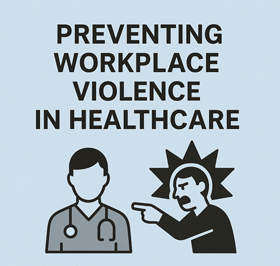New and Revised TJC Workplace Violence Prevention Requirements
 The Joint Commission has revised its workplace violence requirements, which will be effective July 1st, 2025, for multiple care settings. “Workplace violence poses a significant occupational hazard for health care workers. However, the prevalence may be underestimated due to underreporting, as incidents are often perceived as minor. To address the safety concerns that affect patients, staff, and visitors, The Joint Commission is implementing accreditation requirements for workplace violence prevention.”
The Joint Commission has revised its workplace violence requirements, which will be effective July 1st, 2025, for multiple care settings. “Workplace violence poses a significant occupational hazard for health care workers. However, the prevalence may be underestimated due to underreporting, as incidents are often perceived as minor. To address the safety concerns that affect patients, staff, and visitors, The Joint Commission is implementing accreditation requirements for workplace violence prevention.”
New standards have been issued for all Joint Commission-accredited assisted living communities, nursing care centers, and office-based surgery practices, as well as ambulatory health care organizations and laboratories. The new and revised requirements also provide a framework to assist in developing prevention strategies.
The standards and further information on the revised standards and other Joint Commission updates can be found here: jointcommission.org/standards/prepublication.
New standards have been issued for all Joint Commission-accredited assisted living communities, nursing care centers, office-based surgery practices, ambulatory health care organizations, and laboratories.
Note: For healthcare organizations that are not TJC accredited, CMS and OSHA also have specific requirements you should be familiar with and adhere to.
Medical Mutual has a practice tip for Workplace Violence Management in Healthcare. Please don’t hesitate to reach out to your assigned risk manager for further assistance or call the Medical Mutual Risk department directly at 1-800-942-2791.
This article falls under Legal/Regulatory and Human Capital in the Enterprise Risk Management (ERM) risk domains.
Legal/Regulatory
Risk within this domain incorporates the failure to identify, manage and monitor legal, regulatory, and statutory mandates on a local, state and federal level. Such risks are generally associated with fraud and abuse, licensure, accreditation, product liability, management liability, Centers for Medicare and Medicaid Services (CMS) Conditions of Participation (CoPs) and Conditions for Coverage (CfC), as well as issues related to intellectual property.
Human Capital
This domain refers to the organization’s workforce. Included are risks associated with employee selection, retention, turnover, staffing, absenteeism, on-the-job work-related injuries (workers’ compensation), work schedules and fatigue, productivity, compensation, succession planning and labor unionization activity. Human capital associated risks may cover recruitment, diversity, retention, and termination of members of the medical and allied health staff
